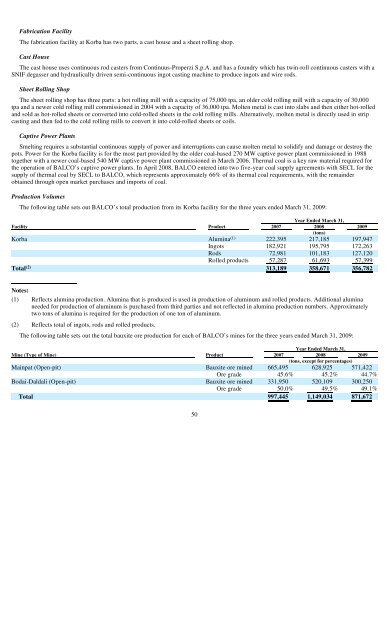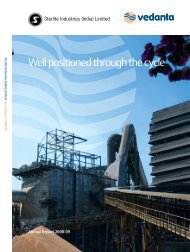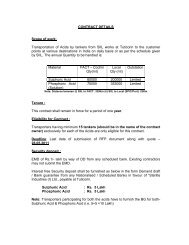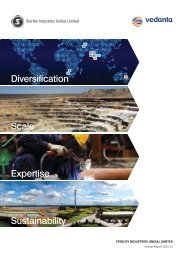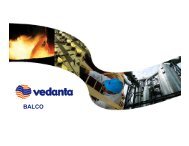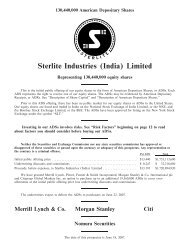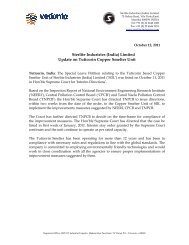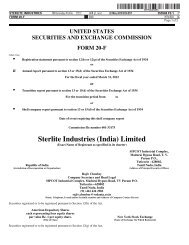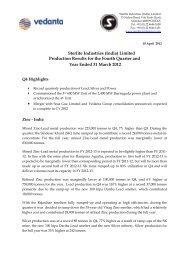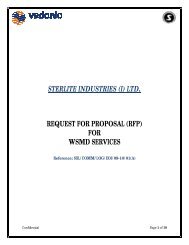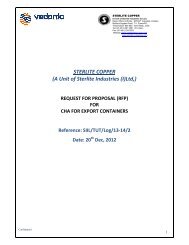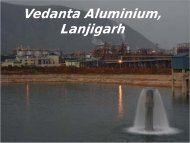Sterlite Industries (India) Limited - Sterlite Industries India Ltd.
Sterlite Industries (India) Limited - Sterlite Industries India Ltd.
Sterlite Industries (India) Limited - Sterlite Industries India Ltd.
Create successful ePaper yourself
Turn your PDF publications into a flip-book with our unique Google optimized e-Paper software.
Fabrication Facility<br />
The fabrication facility at Korba has two parts, a cast house and a sheet rolling shop.<br />
Cast House<br />
The cast house uses continuous rod casters from Continuus-Properzi S.p.A. and has a foundry which has twin-roll continuous casters with a<br />
SNIF degasser and hydraulically driven semi-continuous ingot casting machine to produce ingots and wire rods.<br />
Sheet Rolling Shop<br />
The sheet rolling shop has three parts: a hot rolling mill with a capacity of 75,000 tpa, an older cold rolling mill with a capacity of 30,000<br />
tpa and a newer cold rolling mill commissioned in 2004 with a capacity of 36,000 tpa. Molten metal is cast into slabs and then either hot-rolled<br />
and sold as hot-rolled sheets or converted into cold-rolled sheets in the cold rolling mills. Alternatively, molten metal is directly used in strip<br />
casting and then fed to the cold rolling mills to convert it into cold-rolled sheets or coils.<br />
Captive Power Plants<br />
Smelting requires a substantial continuous supply of power and interruptions can cause molten metal to solidify and damage or destroy the<br />
pots. Power for the Korba facility is for the most part provided by the older coal-based 270 MW captive power plant commissioned in 1988<br />
together with a newer coal-based 540 MW captive power plant commissioned in March 2006. Thermal coal is a key raw material required for<br />
the operation of BALCO’s captive power plants. In April 2008, BALCO entered into two five-year coal supply agreements with SECL for the<br />
supply of thermal coal by SECL to BALCO, which represents approximately 66% of its thermal coal requirements, with the remainder<br />
obtained through open market purchases and imports of coal.<br />
Production Volumes<br />
The following table sets out BALCO’s total production from its Korba facility for the three years ended March 31, 2009:<br />
Year Ended March 31,<br />
Facility Product 2007 2008 2009<br />
(tons)<br />
Korba Alumina (1) 222,395 217,185 197,947<br />
Ingots 182,921 195,795 172,263<br />
Rods 72,981 101,183 127,120<br />
Rolled products 57,287 61,693 57,399<br />
Total (2) 313,189 358,671 356,782<br />
Notes:<br />
(1) Reflects alumina production. Alumina that is produced is used in production of aluminum and rolled products. Additional alumina<br />
needed for production of aluminum is purchased from third parties and not reflected in alumina production numbers. Approximately<br />
two tons of alumina is required for the production of one ton of aluminum.<br />
(2) Reflects total of ingots, rods and rolled products.<br />
The following table sets out the total bauxite ore production for each of BALCO’s mines for the three years ended March 31, 2009:<br />
Year Ended March 31,<br />
Mine (Type of Mine) Product 2007 2008 2009<br />
(tons, except for percentages)<br />
Mainpat (Open-pit) Bauxite ore mined 665,495 628,925 571,422<br />
Ore grade 45.6% 45.2% 44.7%<br />
Bodai-Daldali (Open-pit) Bauxite ore mined 331,950 520,109 300,250<br />
Ore grade 50.0% 49.5% 49.1%<br />
Total 997,445 1,149,034 871,672<br />
50


